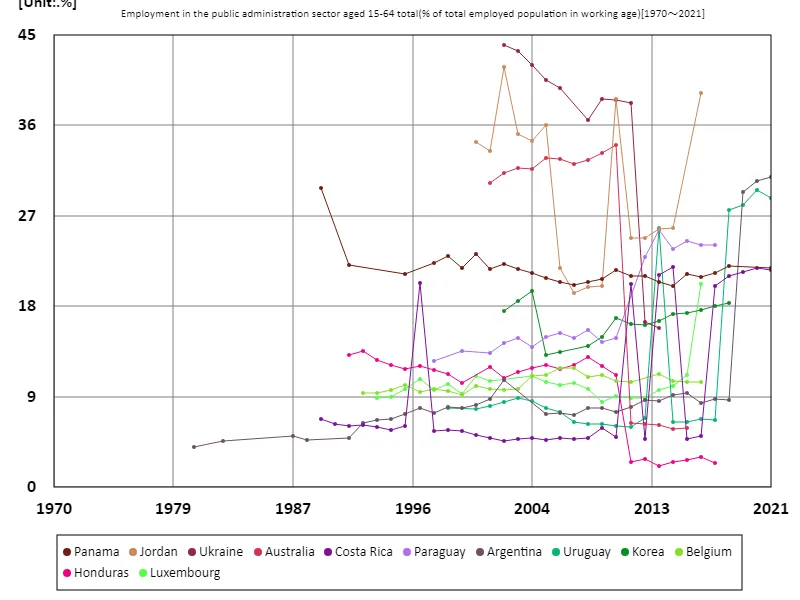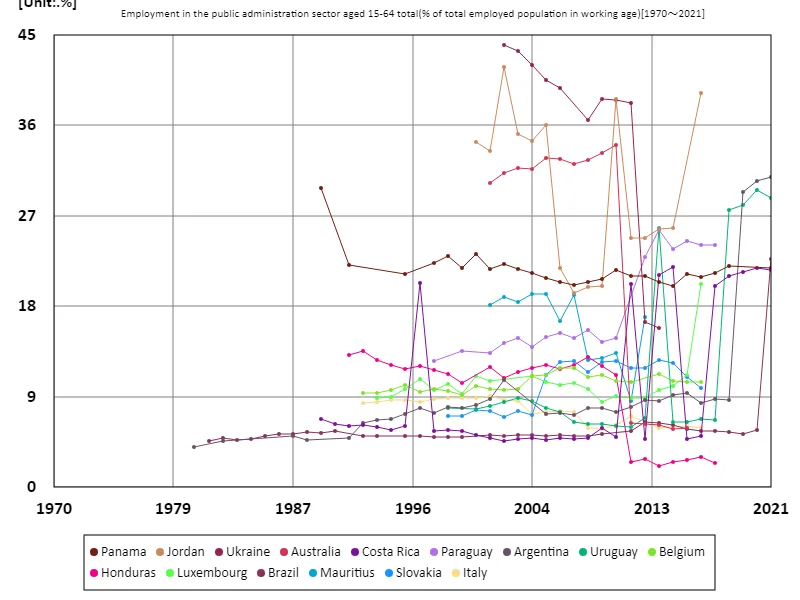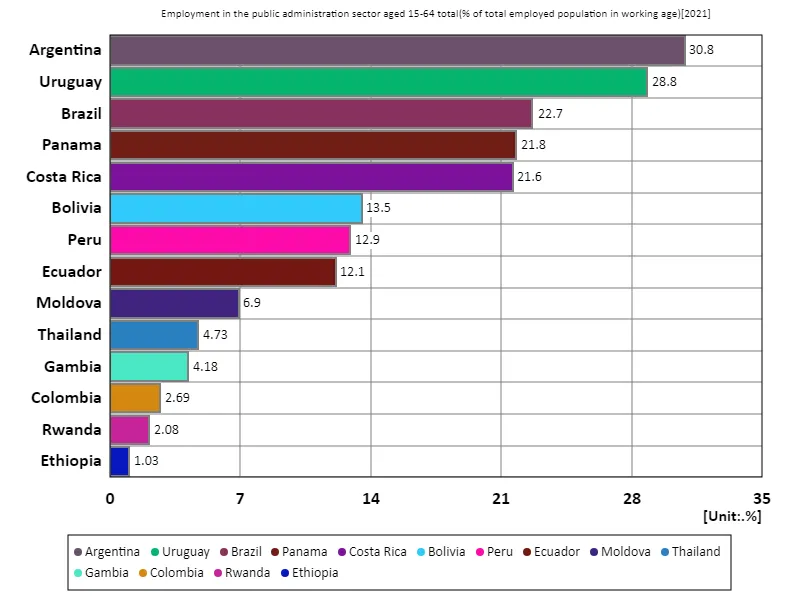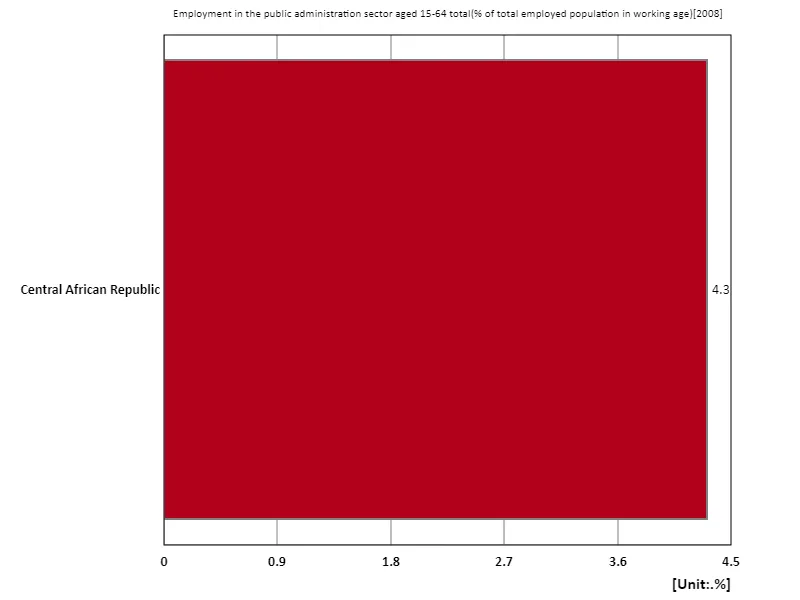- Abstract
- Employment rate in the public administration sector for all 15-64 year olds (percentage of working-age population)
- Employment rate in the public administration sector for all 15-64 year olds (percentage of working-age population) (Worldwide)
- Employment rate in the public administration sector for all 15-64 year olds (percentage of working age working population) (Worldwide, latest year)
- Employment rate in the public administration sector for all 15-64 year-olds (percentage of working-age working population) (region, latest year)
- Reference
Abstract
Data shows that employment in Argentina’s public administration sector reached 30.8% in 2021, a high level compared to other countries. This high employment rate suggests that Argentina’s economic structure and government play a large role. Public sector employment is particularly prevalent in developing countries and those with unstable economies, where governments focus on stabilizing the economy and providing social services. Argentina has seen the expansion of its public sector in the past, and government intervention in the economy and job creation are historical trends. However, too high a public sector employment rate can also create financial burdens and efficiency problems.
Employment rate in the public administration sector for all 15-64 year olds (percentage of working-age population)
Ukraine recorded the highest rate of employment in the public administration sector in the 1980-2021 data, with a high rate of 44% in 2002. This high level can be seen as a result of the massive expansion of the public sector by the Ukrainian government in response to the social and economic challenges of the time. High public sector employment reflects the government being the main employment provider and its focus on providing social security and public services. However, employment in Ukraine’s public administration has declined from its peak and now stands at 36 percent. This change reflects the economic reforms, structural adjustment, increased privatization, and efforts at fiscal consolidation since the 2000s. The trend of declining public sector employment is observed in many countries, especially as they transition to a market economy, improve efficiency and consolidate finances. In Ukraine’s case, the decline in public sector employment suggests a changing role for government and growth in the private sector, aiming to make the economy more flexible and efficient. Overall, employment rates in the public administration sector fluctuate in response to each country’s economic policies and reforms, especially as economic reforms and efficiency gains progress.


The maximum is 44%[2002] of Ukraine, and the current value is about 36%
Employment rate in the public administration sector for all 15-64 year olds (percentage of working-age population) (Worldwide)
Data for the period 1980-2021 show that Ukraine recorded its highest employment rate in the public administration sector in 2002, at 44%. This high percentage is seen as a result of Ukraine’s massive expansion of the public sector in response to the economic difficulties and social demands of the time. The public sector has become the major source of employment, reflecting the government’s focus on stabilizing the economy and providing social services. However, the current employment rate stands at 36%, representing a significant decline from the peak. The decrease is the result of increased public sector efficiency, privatization and fiscal consolidation as part of Ukraine’s economic reforms and structural adjustment. Since the 2000s, economic liberalization and market expansion have progressed, and there has been a growing movement to reduce the size of the public sector. This has led to a shrinking role for the public sector and making the private sector a more important source of employment. Overall, employment rates in the public administration sector fluctuate depending on each country’s economic policies and reforms, and tend to decline especially as economies become more liberalized and efficient. The example of Ukraine is part of this, and the data reflects the changing role of the public sector.


The maximum is 44%[2002] of Ukraine, and the current value is about 36%
Employment rate in the public administration sector for all 15-64 year olds (percentage of working age working population) (Worldwide, latest year)
Data for 2021 show that Argentina has the highest public administration employment rate at 30.8%, reflecting the country’s economic structure and the role of its government. High public sector employment suggests that government has a broad range of service delivery and social roles. In comparison, the overall average employment rate is 13.3%, with many countries seeing relatively low levels of public sector employment. This reflects the large role of the private sector and efforts by governments to become more efficient and downsize. The overall total figure of 186% may be influenced by the way the data is compiled and by special circumstances in each country. For example, this could be due to aggregation from multiple data sources or the impact of excess government employment in certain countries. Fluctuations in public sector employment reflect changes in each country’s economic policies and the role of government, as well as the impact of economic reforms, particularly trends such as economic liberalization and increased efficiency. Argentina’s high percentage reflects the government’s reliance on the public sector to stabilize the economy.


The maximum is 30.8% of Argentina, the average is 13.3%, and the total is 186%
Employment rate in the public administration sector for all 15-64 year-olds (percentage of working-age working population) (region, latest year)
According to 2008 data, the Central African Republic had the highest public administration employment rate at 4.31%, as did the average and total at 4.31%. This figure indicates a relatively low level of public sector employment in the Central African Republic, which may be due to the country’s economic situation, the size of the government, or the way public services are delivered. The low employment rate in the public sector may be due to a lack of resources, economic constraints, and limited government capabilities. Overall, relatively low public sector employment rates are a common trend across many countries, particularly in developing countries where the public sector is often small. This is due to encouraging private sector growth, fiscal efficiency, and limiting government spending. The example of the Central African Republic reflects this trend and illustrates the current economic constraints on public sector employment. Overall, we can see that public sector employment rates depend heavily on each country’s level of economic development and the role of government.


The maximum is 4.31% of Central African Republic, the average is 4.31%, and the total is 4.31%



Comments